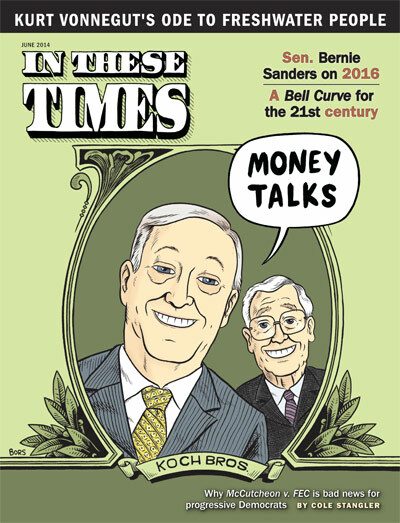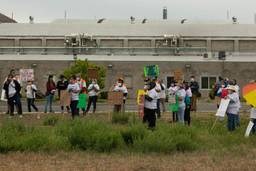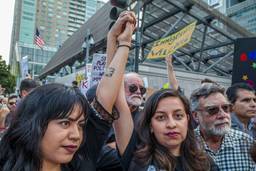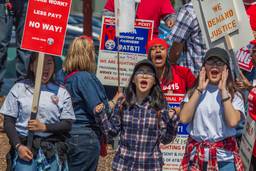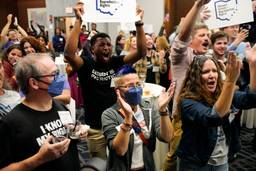What Cesar Chavez Missed
The new film doesn’t capture the diversity of the farmworkers’ movement.
David Bacon
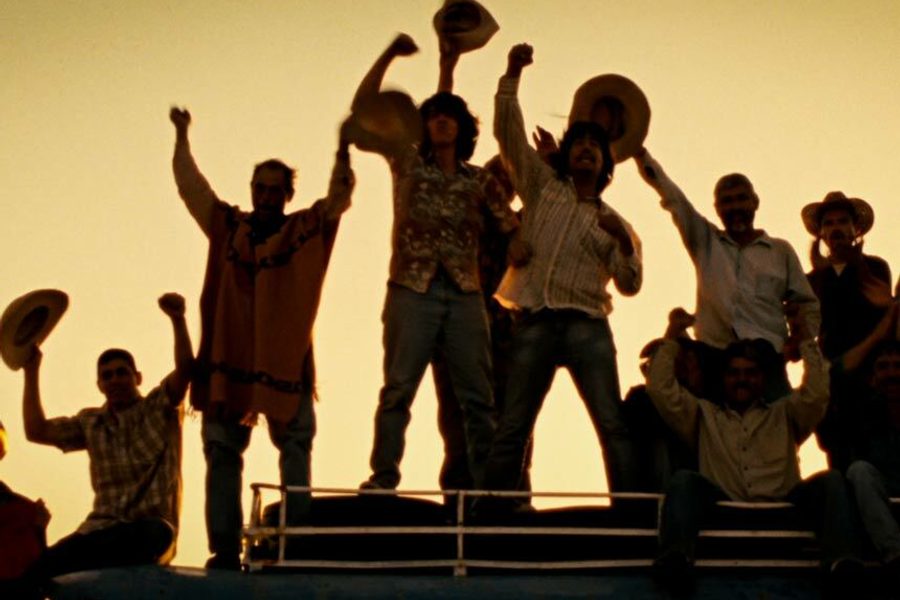
The new movie Cesar Chavez: History is Made One Step at a Time, directed by Diego Luna, tells the story of the Delano Grape Strike that began in 1965. This epic five-year labor battle led to the founding of the United Farm Workers (UFW), and made Cesar Chavez a social movement hero. The movie has provoked controversy over its depiction of his role, and the accuracy of the history it recounts of those events.
In this roundtable, In These Times explores these themes with Eliseo Medina, who was a farmworker when the strike started and became a noted labor organizer, first in the UFW and later in the Service Employees International Union; Doug Adair, an activist in the 1965 strike who has continued working on farms in the Coachella Valley; Dawn Mabalon, a professor of history at San Francisco State University who studies the history of Filipinos in California; and Rosalinda Guillen, who comes from a farmworker family in Washington State, worked as a UFW organizer, and today organizes farm labor in the Skagit and Whatcom Counties, north of Seattle, with Community2Community. (The interviewer, labor journalist David Bacon, is also a former organizer for the UFW.)
How did the movie square with your memories of the grape strike as a participant?
Eliseo: It’s a good time for this movie to come out and show not only the challenges immigrants face, but also the fact that they’re willing to struggle and that when they do they can win, regardless of the power structure. It could’ve done a much better job of telling the full story, but it’s impossible to tell 10 years worth of history in 2 hours. It’s a movie, not a documentary, and its aim is not to tell the story of the whole movement. To do that would take a lot more than just one movie.
The UFW was a multinational union, including Filipinos, African Americans, Arab-Americans and European-Americans, as well as Chicanos. Does that come through in the film?
Eliseo: When I was a farmworker, before the strike, we lived in different worlds — the Latino world, the Filipino world, the African-American world and the Caucasian world. We co-existed but never understood who we were or what each other thought and dreamed about. It wasn’t until the union began that we finally began to work together, to know each other and to begin to fight together. I do wish that that had been more explicit. Certainly the contribution that was made by the Filipino workers to the strike was an incredible part of the success of the union. The fact that we also had Caucasians and African-Americans participating in the strike never even gets brought up. It was always multi-racial. I do wish it had focused more on showing what can happen when people work together and fight together and make changes, not only for one group, but for everybody.
Dawn: The first person killed in the strike was a Yemeni worker, but in the movie, it’s portrayed as someone who’s Mexican. The filmmakers didn’t really understand the multinationalism that made the strike so powerful.
The movie’s portrayal of Filipino workers has been criticized. How do you feel about that?
Dawn: Filipinos had been organizing, not just that year, but for decades. The growers had always divided Mexicans and Filipinos. What was so powerful about that moment in Delano, California, was that those two groups defied this. But the way they came together was downplayed. There was so little context that there’s no understanding that it was these other people, in particular Larry Itliong, who really sparked the strike. Larry went to Delano in the early 1960s, sent by the Agricultural Workers Organizing Committee (AWOC). He already had decades of labor experience with the Alaskan salmon cannery union. He organized with the failed strike of asparagus workers in Stockton in 1948 and a successful strike in 1949. He had more experience than everyone, Dolores Huerta and Cesar included. Unfortunately he died a few years after the UFW and didn’t leave much behind for us. We’re still trying to piece together how important he was, not just to the Filipino-American community, but to American labor in general. But we know he was really pivotal to this strike and to the early years of the UFW. He resigned in 1971, so he often gets left out of that larger history.
Doug: The original spark in Delano was when Filipino workers began sitting in at the camps. It wasn’t a strike with picket lines, but a sit-in and refusing to go to work.
The movie starts with a little section where Cesar is the head of the Community Service Organization (CSO), but doesn’t show him organizing protests about the bracero program, in which growers were able to bring workers from Mexico under very abusive conditions, sending them back at the end of the season. Should the movie have said more about it?
Doug: Workers first went on strike in Coachella in the spring of 1965 because of the bracero program. AWOC demanded the same wage as the temporary workers. That was the spark that set off the strike. Actually if it had been up to Cesar, there wouldn’t have been a strike in Delano because he didn’t feel our union was ready. There was no money in the bank, and he wanted to do more organizing. He used to say “we’re not a union, and we’re not gonna start strikes.”
Rosalinda: For us, organizing farmworkers and opposing guestworker [bracero-type] programs today, it’s clear why Cesar opposed the bracero program. Growers at that time used the program to break strikes, when workers tried to form unions. It’s still happening today, to farmworkers in Burlington, Washington who went on strike last year. When I joined the United Farmworkers in 1996, the union opposed the H2A guest worker visa program very strongly. Leaving out that history was a wasted opportunity to include more political context that is still important to us.
The movie stops when the industry-wide grape contract gets signed. Did the contract change life for farmworkers in the long term?
Doug: When I worked under that first contract, [most pickers’] wages and benefits were over double the minimum wage. We had a health plan that was the envy of many other unions. We could sit down with the growers and negotiate over grievances. We wouldn’t always win, but we could negotiate our working conditions. The movie did show that workers can join together in spite of appalling conditions and improve their wages and working conditions and change history.
Eliseo: Clearly the union was able to begin lifting workers out of poverty. They had paid holidays, vacations and health insurance. Unfortunately, at the time when we were poised to completely change these workers’ lives we lost focus. As a result, workers today are back where they were before the union. Most are working at minimum wage again. Employers are back to just trying to get the work done in the cheapest way possible, regardless of the impact on workers.
Doug: Today, wages are nowhere near even the miserable minimum wage. There are a few advances in pesticide regulations, toilets in the fields, shade and drinking water — minimal things that didn’t exist in 1965. But the presence of the union in the Coachella Valley is a shadow of its former self. Just a few pensioners like me.
Rosalinda: Today farmworkers can organize because of the example of the farmworkers in the 1960s and 1970s in California. This is one of the legacies of Cesar Chavez, this coming together of different workers with different religions and different political views. Unfortunately, today we have a splintered movement and divided communities. We see the same old attacks, like this guestworker program, to stop farmworkers from organizing for better wages and better treatment.
Dawn: My father died working the asparagus nine years ago. I wish the film had been much stronger in saying these conditions still exist today and we still have to fight for farmworkers. I was hoping at the end of the film you would have this feeling of inspiration and a call to action, but you get the sense that now we won and it’s over.
What did the movie do well?
Doug: It showed the viciousness of the growers and their local power structure; district attorneys and the cops and thugs on the side of the growers. The whole local structure was against the union and the farmworkers.
In one scene the sheriff and the growers accuse the unions of being Communist, and Cesar says that’s silly, we’re Catholic. But the Filipinos, in their prior organizing, had been very left-wing. Is this underplayed?
Dawn: There was always tension between the Filipino leftists/Marxists/Communists and anti-communism within the UFW. Larry Itliong considered Chris Mensalvas one of his mentors, who organized Filipino lettuce workers in Salinas in the 1930s and was considered by the FBI one of the most dangerous Communist labor organizers of his day. The union Larry came from, ILWU Local 37, was led by leftists and members of the Communist Party. [UFW leader] Philip Vera Cruz was an ardent leftist. By erasing Filipinos, you also downplay those radical roots. Even nonviolence was a tension for Filipinos, who were used to using violence against scabs who crossed thepicket lines, and were uncomfortable with hunger strikes, marches and religious pageantry.
Doug: The movie stressed Cesar saying, “We’re Catholic, so we couldn’t possibly be Communists,” but in fact, a strong element in the union was anti-clerical. The church in Mexico was always on the side of the growers and the wealthy and always against the peasants and the poor. Typically the Protestants among farmworkers had rebelled against the Catholic church and were rebels at heart and were especially receptive to the union. And the young Filipinos in the movement were revolutionaries, fighting to overturn the whole system. The march to Sacramento was a very radical statement — that we wanted to overturn this whole corrupt structure. We were the people that were feeding America and that we had a right to be at the table.
The Filipino community is not united in their view of Cesar or the union, are they?
Dawn: The Stockton community is divided over the legacy of the United Farm Workers. I think that Larry Itliong’s compadres became very bitter about what happened to him, and that Filipino voices had been drowned out in the union. There’s also the issue of Cesar’s visit with [Philippine dictator Ferdinand] Marcos. The community was already split about the Marcos dictatorship. It’s a very complex legacy.
Doug: Many of the leaders in the Filipino community were foremen. They had a tradition of representing their workers and pursuing better wages and working conditions for their crews. Larry would work with foremen to get whole crews on board. The growers began signing , and some foremen urged their crews to make the switch. But many of the strongest Filipino workers and foremen stayed with the UFW because they were too radical to negotiate with growers. Doug: Many of the leaders in the Filipino community were foremen. They had a tradition of representing their workers and trying to get better wages and working conditions for the crew. Larry mostly organized through them and got whole crews on board. But when it became clear the strike was going to be broken a lot decided it was time to go back to work, and made a deal with the growers. When the [UFW] contracts did come in, the powers of the foremen were stripped away. The growers started signing contracts with the Teamsters, and they offered those foremen their powers back. Many of the Filipino foremen urged their crews to switch to the Teamsters. But many of the strongest Filipino workers, who had been foremen, stayed with the UFW because they were too radical to negotiate with the growers.
Rosalinda: Now more than ever we need to see how movements are built. Organizing is not perfect - there is conflict. It’s almost like this movie was pulled together to make Cesar a kind of superhero instead of understanding how difficult it is to build a union from the bottom up.
At one point the growers say they are going to bring in “illegals” [the movie uses this word] by the truckload. Do you think this experience shaped how Cesar saw the question of immigration?
Eliseo: The growers knew very well that divide-and-conquer was an important strategy. And they certainly felt that having a captive work force would make it easier for them. Cesar was well aware, as were all of us, that the union and the strike was a movement of documented and undocumented people. Some of the strongest and most active people were undocumented. For the undocumented, being for the union was a lot more serious because it potentially meant arrest and deportation, leaving their families behind. The union was very conscious about this and made it their policy to defend those workers.
Doug: Whether they had papers or not, if they were strikebreakers we wanted them out of there. At different points in the union’s history, it’s taken a very hard line against people without papers. The union’s base was the permanent families who lived in Delano.
Rosalinda: In my time in the union, I did not see any behavior that was in any way anti-immigrant. Today when we’re opposing guestworkers, we’re not against Mexican workers who are being brought in. We’re against this program that legalizes wage theft, because they’re displacing the workers who are already here. The issue of blocking the guestworker program was central to the union’s political work, because the agricultural industry uses this program to slow down farmworker organizing. The growers try to turn Mexican and Filipino against one another, the poorest of the poor and the most desperate.
Most people’s experience of the union was not in the fields, but as supporters in the boycotts. What do you think about the picture that the movie painted of the grape boycott?
Doug: By late November 1965, it was clear that the strike had been broken — we weren’t going to win the strike in the fields. The boycott was one of Cesar’s many ideas to finesse the local power structure and get the American public involved. Cesar’s genius was not in being the one handing out leaflets but in putting together a team and sending people out to cities all across the country, and in fact, all across the world. For example, a woman named Elaine Elinson organized in London. The American embassy in London was promoting grapes, and meanwhile the transport union and other unions in England supported the boycott.
Dawn: Larry Itliong and other Filipinos like Pete Velasco were also a strong part of the boycott. For the Filipino-Americans who were inspired by Larry, those were some of their best memories of being involved in the movement.
Any last words?
Doug: I cry in movies, and I cried in this one.
Dawn: As disappointed as some of us may be, I think the movie has given us this amazing opportunity to dialogue, and to continue to be involved in farmworker justice and issues where we need to coalesce with the Latino community, like immigration reform. It’s made young Filipinos go, “Why aren’t we in it?” and “I want to know more.” I think that’s amazing. I’d also like to mention that a talented Filipinio filmmaker named Marissa Aroy has made a film called The Delano Manongs, which includes some amazing archival footage of Filipinos striking and brings more nuance to this movement.
Eliseo: Cesar’s legacy today is that thousands of people learned the skill of organizing and are making their own contribution to a more just society. A lot of the strategy and inspiration comes straight out of the farmworker movement. I hope the next Diego Luna will be inspired to take a look at the whole story. It has a lot of lessons about organizing and perseverance, and the theory and practice of non-violence and how it can lead to major social change. It’s a story that needs to be told.
